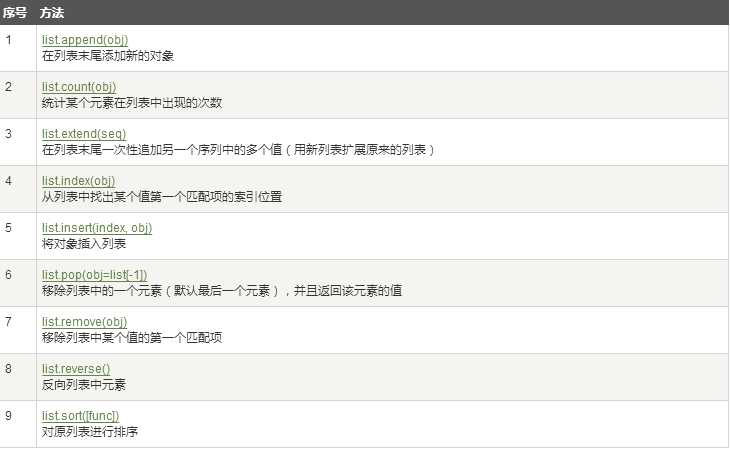标签:
序列是Python中最基本的数据结构。
(1)序列简介:
序列中的每个元素都分配一个数字标明它的位置或索引,第一个索引是0,第二个索引是1,依此类推。序列都可以进行的操作包括索引,切片,加,乘,检查成员。 此外,Python已经内置确定序列的长度以及确定最大和最小的元素的方法。
Python有6个序列的内置类型,但最常见的是列表和元组。
(2)列表:
列表可以作为一个方括号内的逗号分隔值出现。列表的数据项不需要具有相同的类型。创建一个列表,只要把逗号分隔的不同的数据项使用方括号括起来即可。如下所示:
list= [‘name‘, ‘age‘, True, [87,98,‘sjm‘],‘sex‘];
在前面已经介绍列表的访问、更新和删除、列表脚本操作符和列表的截取。这里主要介绍列表函数和方法(主要针对2.7.x版本,Python3.5版本没有这些函数):
1.Python2.7.*: root@SJM:/home/sunjimeng/桌面# python Python 2.7.6 (default, Mar 22 2014, 22:59:56) [GCC 4.8.2] on linux2 Type "help", "copyright", "credits" or "license" for more information. >>> cmp <built-in function cmp> >>> len <built-in function len> >>> max <built-in function max> >>> min <built-in function min> >>> list <type ‘list‘> >>> exit() 2.python3.5.*: root@SJM:/home/sunjimeng/桌面# python3.5 Python 3.5.2 (default, Jul 17 2016, 11:52:15) [GCC 4.8.4] on linux Type "help", "copyright", "credits" or "license" for more information. >>> cmp #高版本里没有cmp了 Traceback (most recent call last): File "<stdin>", line 1, in <module> NameError: name ‘cmp‘ is not defined >>> len <built-in function len> >>> max <built-in function max> >>> min <built-in function min> >>> list <class ‘list‘> #这里也由type变成了class
1)函数:
1.cmp(list1, list2)用于比较两个列表的元素:
比较原则:
1.如果比较的元素是同类型的,则比较其值,返回结果。 2.如果两个元素不是同一种类型,则检查它们是否是数字。 3.如果是数字,执行必要的数字强制类型转换,然后比较。 4.如果有一方的元素是数字,则另一方的元素"大"(数字是"最小的") 5.否则,通过类型名字的字母顺序进行比较。 6.如果有一个列表首先到达末尾,则另一个长一点的列表"大"。 7.如果我们用尽了两个列表的元素而且所有元素都是相等的,那么结果就是个平局,就是说返回一个 0。
比较实例:
root@SJM:/home/sunjimeng/桌面# python Python 2.7.6 (default, Mar 22 2014, 22:59:56) [GCC 4.8.2] on linux2 Type "help", "copyright", "credits" or "license" for more information. >>> list1=[‘abcd‘,10] >>> list2=[‘accd‘,10] >>> list3=[‘abcd‘,11] >>> list4=[‘abcd‘,10] >>> cmp(list1,list2) -1 >>> cmp(list1,list3) -1 >>> cmp(list1,list4) 0 >>> list1=[‘adc‘,1,1] #从第一个元素开始比较 >>> list2=[‘adc‘,5] >>> cmp(list1,list2) -1
2.min(list)和max(list)用于返回一个列表元素中的最大值和最小值:
max(list)返回列表元素中的最大值;min(list)返回列表中的最小值;
Python2.7.*版本允许存不同类型元素的列表大小值的比较,但Python3.5.*版本只允许相同元素的列表比较
1.Python2.7.*:
root@SJM:/home/sunjimeng/桌面# python Python 2.7.6 (default, Mar 22 2014, 22:59:56) [GCC 4.8.2] on linux2 Type "help", "copyright", "credits" or "license" for more information. >>> list=[‘abc‘,True,10,20] >>> min(list),max(list) #Python2.7.*版本的最小值是布尔型,最大值是字符值 (True, ‘abc‘) >>> exit()
2.Python3.5.*: root@SJM:/home/sunjimeng/桌面# python3.5 Python 3.5.2 (default, Jul 17 2016, 11:52:15) [GCC 4.8.4] on linux Type "help", "copyright", "credits" or "license" for more information. >>> list1=[‘abc‘,True,10,20] >>> list2=[10,20,30,40] >>> min(list1),max(list1) #当列表中存不同类型元素时不能比较 Traceback (most recent call last): File "<stdin>", line 1, in <module> TypeError: unorderable types: bool() < str() >>> min(list2),max(list2) (10, 40) >>> list3=[True,False] #False的值小于True >>> min(list3),max(list3) (False, True)
3.len() 方法返回列表元素个数:
两个版本一样的:
1.Python2.7.*:
root@SJM:/home/sunjimeng/桌面# python Python 2.7.6 (default, Mar 22 2014, 22:59:56) [GCC 4.8.2] on linux2 Type "help", "copyright", "credits" or "license" for more information. >>> list=[‘abc‘,True,20] >>> len(list) 3 >>> exit()
2.Python3.5.*: root@SJM:/home/sunjimeng/桌面# python3.5 Python 3.5.2 (default, Jul 17 2016, 11:52:15) [GCC 4.8.4] on linux Type "help", "copyright", "credits" or "license" for more information. >>> list=[‘abc‘,True,20] >>> len(list) 3
4.list(tuple)将一个元组转化为列表:
两个版本一样的:
1.Python2.7.*:
root@SJM:/home/sunjimeng/桌面# python Python 2.7.6 (default, Mar 22 2014, 22:59:56) [GCC 4.8.2] on linux2 Type "help", "copyright", "credits" or "license" for more information. >>> tuple=(‘abc‘,True,20) >>> list=list(tuple) >>> list [‘abc‘, True, 20] >>> exit()
2.Python3.5.*: root@SJM:/home/sunjimeng/桌面# python3.5 Python 3.5.2 (default, Jul 17 2016, 11:52:15) [GCC 4.8.4] on linux Type "help", "copyright", "credits" or "license" for more information. >>> tuple=(‘abc‘,True,20) >>> list=list(tuple) >>> list [‘abc‘, True, 20]
2)方法:
Python包含以下方法:

1.Python2.7.*列表方法测试:
root@SJM:/home/sunjimeng/桌面# python Python 2.7.6 (default, Mar 22 2014, 22:59:56) [GCC 4.8.2] on linux2 Type "help", "copyright", "credits" or "license" for more information. >>> list=[‘abc‘,20,‘abc‘,True,9j] #1.append()追加元素到末尾 >>> list.append(20) >>> list [‘abc‘, 20, ‘abc‘, True, 9j, 20] #2.count()计算20在列表中存在的个数 >>> list.count(‘abc‘),list.count(20) (2, 2) #3.extend()将另一个列表中的所有元素加到当前列表的末尾 >>> list.extend(list) >>> list [‘abc‘, 20, ‘abc‘, True, 9j, 20, ‘abc‘, 20, ‘abc‘, True, 9j, 20] #4.index()返回首次匹配元素的下标 >>> list.index(True) 3 #5.insert()在指定位置插入元素 >>> list.insert(0,‘abc‘) >>> list [‘abc‘, ‘abc‘, 20, ‘abc‘, True, 9j, 20, ‘abc‘, 20, ‘abc‘, True, 9j, 20] #6.pop()删除并返回列表末尾元素 >>> temp=list.pop() #pop中不需要keyborder >>> temp 20 >>> list [‘abc‘, ‘abc‘, 20, ‘abc‘, True, 9j, 20, ‘abc‘, 20, ‘abc‘, True, 9j] #7.remove()移除第一个匹配的对象 >>> list.remove(20),list (None, [‘abc‘, ‘abc‘, ‘abc‘, True, 9j, 20, ‘abc‘, 20, ‘abc‘, True, 9j]) #8.reverse()将列表反向 >>> list.reverse(),list (None, [9j, True, ‘abc‘, 20, ‘abc‘, 20, 9j, True, ‘abc‘, ‘abc‘, ‘abc‘]) #9.将列表排序 >>> list.sort(),list Traceback (most recent call last): File "<stdin>", line 1, in <module> TypeError: no ordering relation is defined for complex numbers >>> list.remove(9j) >>> list [True, ‘abc‘, 20, ‘abc‘, 20, 9j, True, ‘abc‘, ‘abc‘, ‘abc‘] >>> list.remove(9j) >>> list #负数不能按大小排序 [True, ‘abc‘, 20, ‘abc‘, 20, True, ‘abc‘, ‘abc‘, ‘abc‘] >>> list.sort() >>> list [True, True, 20, 20, ‘abc‘, ‘abc‘, ‘abc‘, ‘abc‘, ‘abc‘]
2.Python3.5.*列表测试:
除了不能使用sort()函数给存不同元素的列表排序之外,其余相同。
root@SJM:/home/sunjimeng/桌面# python3.5 Python 3.5.2 (default, Jul 17 2016, 11:52:15) [GCC 4.8.4] on linux Type "help", "copyright", "credits" or "license" for more information. >>> list=[‘abv‘,20,45,True] >>> list_N=[10,30,20,40,0] >>> list.sort() Traceback (most recent call last): File "<stdin>", line 1, in <module> TypeError: unorderable types: int() < str() >>> list_N.sort() >>> list_N [0, 10, 20, 30, 40]
(3)元组:
Python的元组与列表类似,不同之处在于元组的元素不能修改。元组使用小括号,列表使用方括号。元组创建很简单,只需要在括号中添加元素,并使用逗号隔开即可:
>>> tuple=(98,‘MenAngel‘,True,[‘name‘,10,‘age‘,True]) >>> tuple[3] [‘name‘, 10, ‘age‘, True] >>> tuple[3][1]=20 >>> tuple[3] [‘name‘, 20, ‘age‘, True] >>> tuple[0]=True Traceback (most recent call last): File "<stdin>", line 1, in <module> TypeError: ‘tuple‘ object does not support item assignment
1.创建空元组与只有一个元素的元组:(Python2.7.*与Python3.5.*相同):
root@SJM:/home/sunjimeng/桌面# python Python 2.7.6 (default, Mar 22 2014, 22:59:56) [GCC 4.8.2] on linux2 Type "help", "copyright", "credits" or "license" for more information. >>> tuple1=() >>> tuple2=(20) #这里代表int型 >>> tuple3=(20,) #这里代表tuple型 >>> tuple4=(20,20) >>> tuple,tuple1,tuple2,tuple3 (<type ‘tuple‘>, (), 20, (20,)) >>> tuple1,tuple2,tuple3,tuple4 ((), 20, (20,), (20, 20))
2.元组的连接:(结合元素运算符)
访问元组和访问列表的方法相同,但元组不允许修改,但可以对元组进行连接组合形成新的元组:
>>> tuple1=(20,) >>> tuple2=(‘sex‘,20) >>> tuple1+tuple2 (20, ‘sex‘, 20) >>> tuple2*2 (‘sex‘, 20, ‘sex‘, 20)
3.元组的删除:
元组中的单个元素是不允许删除的,只能删除整个元组。用del语句:
>>> t1=(‘name=MenAngel‘, ‘sex=True‘, ‘age=19‘) >>> t1 (‘name=MenAngel‘, ‘sex=True‘, ‘age=19‘) >>> del t1 >>> t1 Traceback (most recent call last): File "<stdin>", line 1, in <module> NameError: name ‘t1‘ is not defined
4.元组内置函数:
Python元组包含了以下内置函数:
root@SJM:/home/sunjimeng/桌面# python Python 2.7.6 (default, Mar 22 2014, 22:59:56) [GCC 4.8.2] on linux2 Type "help", "copyright", "credits" or "license" for more information. >>> print ‘abc‘,456,True #默认为tuple,无关闭分隔符 abc 456 True >>> t1=(‘age‘,‘sex‘,20,True) >>> t2=(‘aga‘,‘sss‘,90,True) >>> cmp(t1,t2) 1 >>> len(t1),len(t2) (4, 4) >>> max(t1),max(t2) (‘sex‘, ‘sss‘) >>> min(t1),min(t2) (True, True) >>> list=[‘age‘,‘sex‘,98,True,r‘sg‘] >>> list [‘age‘, ‘sex‘, 98, True, ‘sg‘] >>> tuple(list) (‘age‘, ‘sex‘, 98, True, ‘sg‘)
tuple没有sort()函数,因为tuple不允许修改。另外max和min函数用的时候Python2.7.*可以用在存不同类型元素的tuple中,但在Python3.5.*就不行了!
标签:
原文地址:http://www.cnblogs.com/MenAngel/p/5691326.html